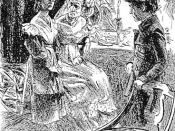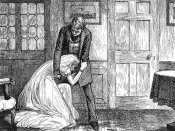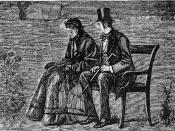Dickens paints a portrait of 19th century society by not telling us but showing us what he wants us to see. To show us this he uses characters from the criminal, lower and upper classes to dramatise each class. Dickens shows us the lower classes mainly by use of the Gargery family as his example of a typical lower class family, but also uses a few other people in conjunction with the Gargery's. For example he shows us that there was a lack of education among the lower classes by using Pip and Joe. When Pip is learning to read and write, Pip writes a message to Joe and at this feat Joe is amazed and calls Pip "a scholar" and is astonished, showing us that it was uncommon to be able to read and write. This point is further proved by the fact that Joe can't read or write as is shown when he tells Pip he is "oncommon fond of reading," which means he likes to read, but he then says that when he reads he can't actually understand or read the words apart from the two letters which make up his name, J and O.
It is the custom of the Gargery family to host a Christmas dinner with a number of people invited to it. This dinner is used to show us how big a gap there is between each class. At the dinner a man named Pumblechook is invited. Pumblechook is lower middle class, and therefore above the Gargery's in society. This means that the fact that he brings the same two gifts as presents every year can be thought about as he is above them and therefore it is an honour for them to have him as their guest. When he presents the presents...


